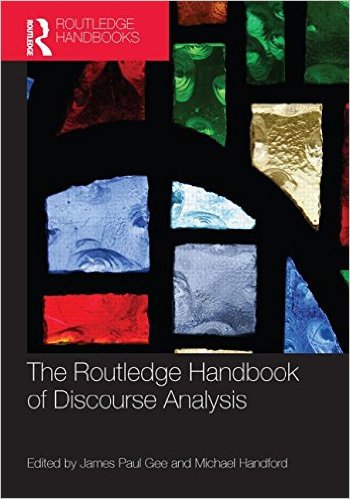 The Routledge Handbook of Discourse Analysis, edited by James Paul Gee and Michael Handford (Routledge, 2012), 681 pages.
The Routledge Handbook of Discourse Analysis, edited by James Paul Gee and Michael Handford (Routledge, 2012), 681 pages.
Several handbooks on discourse analysis have been published lately, including one by Bloomsbury and one by Wiley Blackwell (review coming soon). If I had to rank them, I would rank this Routledge handbook best for non- or beginning linguists, and the Wiley Blackwell volume the best for specialists, while the Bloomsbury edition tries to straddle both worlds but falls a bit shorter in breadth of topics.
The editors include a helpful seven page introduction that situates discourse analysis within the realm of linguistics, providing several examples of language-in-use, how meaning can change given different contexts (pragmatics), and how discourse analysis fits into these different fields. This introduction is the best I have seen in a handbook to explain in a basic way what discourse analysis is.
The work itself is broad and multicultural in its approach. The six parts are approaches to discourse analysis, register and genre, developments in spoken discourse, educational applications, institutional applications, and identity, culture, and discourse. Many of the articles are similar to or nearly the same as several essays in the Wiley Blackwell and Bloomsbury handbooks, such as the essays on register, SFL, English in academia, critical discourse analysis, conversational analysis, etc.
But there is a broader treatment of register and genre, which is a helpful focus, and the section focusing on spoken discourse is also unique. Although those of us who focus on texts are not as interested in spoken discourse, it’s still a phenomenon worthy of study for many reasons, among which are our professional or ministerial interactions with people–through oral discourse.
The last two parts that focus on educational applications and institutional applications betray an interesting focus. Essays include the topics of discourse and the New Literacy Studies, English for academic purposes and discourse analysis, advertising and discourse analysis, media and discourse analysis, discourse and healthcare, discourses in the language of the law, and more. This focus on application in these realms, I think, betrays a slant toward a more critical discourse analysis approach, which is the professional focus of James Gee, one of the editors. Unfortunately critical discourse analysis is not of much help for biblical scholars, unless they want to employ a Marxian hermeneutic of suspicion on documents, a hermeneutic that CDA builds on (see our brief review of Gee’s book).
The final section brings in the multicultural element of the handbook, with an essay specifically on a multicultural approach to discourse studies. Other essays include those on politics, discourse geography, discourse and knowledge by van Dijk, World Englishes and/or English as a lincua franca, and more.
The essays themselves are of decent length, well enough to gain an overview of each topic. The essays then include a section “For Further Reading” that lists 3-5 books for the student to continue the study of the topic. A bibliography is also included, which is often extensive, spanning a couple large pages.
As the editors note in the beginning (and this bears out as you read through the essays), “[I]n designing this handbook, we intended it to be accessible and relevant for the widest possible audience. Discourse analysis is indeed an interdisciplinary approach, and this book should allow readers from various academic backgrounds and disciplines to understand how discourse analysis is done, and why it might be relevant to them” (6). The editors have largely succeeded in their goal.
The one complaint I continue to have with these handbooks on discourse analysis is that they do not focus much on topics that are specifically helpful for those working with classical texts, and that methodologies are rarely seen. That is, one can find essays on topics in discourse analysis, but rarely will one find any help on using a method to execute discourse analysis. One such book that does this is The Semantic Structure of Written Communication, geared specifically toward Bible translators, but it attends too much to semantics and could use a lot more attention to pragmatics and an updated edition to take into account all the advances in discourse analysis over the last 30 years.
Find The Routledge Handbook of Discourse Analysis here on Amazon.
